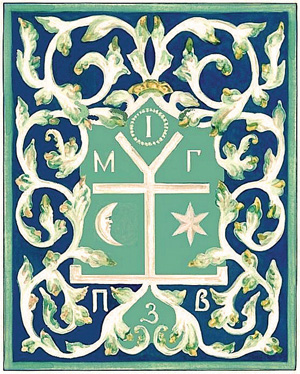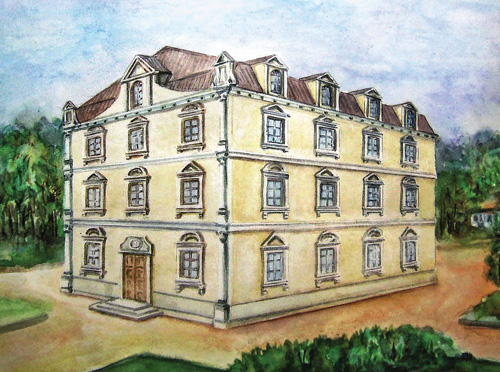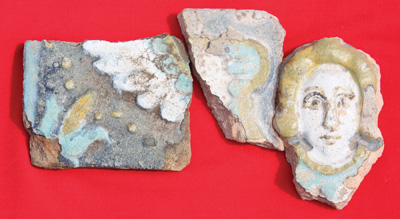 Last summer, the Canada-Ukraine
archaeological expedition conducted research in the town of
Last summer, the Canada-Ukraine
archaeological expedition conducted research in the town of Excavations
of Ivan Mazepa’s Palace in Baturyn
By
Volodymyr Mezentsev
 Last summer, the Canada-Ukraine
archaeological expedition conducted research in the town of
Last summer, the Canada-Ukraine
archaeological expedition conducted research in the town of
Last year, excavations
concentrated on the site of Mazepa’s residence in Honcharivka, a suburb of
Baturyn. Before 1700, the Hetman commissioned a fortified palatial complex
there to house his private quarters, halls for official audiences, councils and
banquets, a library, archives, and collections of portraits and rare weapons.
Archaeological explorations
of the debris of two structures of this complex in 2009 revealed that they were
burned during the Muscovite assault. Researchers excavated the foundations of
the main brick palace’s inner walls and remnants of stairs leading to its
basement. They then prepared graphic reconstructions of the building’s
exterior. The palace measured 20 m by 14.5 m and had a basement with four rooms,
three floors, and an attic. The front elevation was crowned with a pediment and
flanked by semi-columns with composite capitals. This is the earliest known
multi-storey residence in the
 The floors of Mazepa’s
palace were paved with figured terra-cotta and blue-green glazed tiles. The
heating stoves were revetted with fine tiles (kakhli) decorated with
floral relief patterns and images of angels with extended wings. This
particular representation of angels (putti), popular in Cossack art, was
adopted from Western Renaissance or baroque painting and sculpture. Many tiles
have green or multi-coloured glazing.
The floors of Mazepa’s
palace were paved with figured terra-cotta and blue-green glazed tiles. The
heating stoves were revetted with fine tiles (kakhli) decorated with
floral relief patterns and images of angels with extended wings. This
particular representation of angels (putti), popular in Cossack art, was
adopted from Western Renaissance or baroque painting and sculpture. Many tiles
have green or multi-coloured glazing.
In 2009, near the main
palace, archaeologists partly unearthed the remnants of a costly residence of
the period. It had a basement 10 x 9.5 m in size and probably a larger masonry
superstructure. Further excavations are needed to determine its parameters,
plan, and architectural design.
Among the debris of both
palatial buildings in Honcharivka, fragmented ceramic plaques (41 x 33.5 cm)
depicting Hetman Mazepa’s coat of arms have been found. Archaeologists have
graphically reconstructed the design of this heraldic plaque. It bears reliefs of a crescent with a human
face, a star, and a cross surrounded by baroque-style scrolling garlands.
Around the heraldic symbols, there are six Cyrillic letters representing the
initials and abbreviated title of the owner: “Pan Ivan Mazepa, Het’man Viis’ka
Zaporiz’koho” (Lord Ivan Mazepa, Hetman of the Zaporozhian Army). Some plaques
are covered with blue, green, white, and yellow glazing, while others have a
terra-cotta facing. They may have surmounted the portals of both palaces or
have been arranged on their façades in series, like a frieze.
This is a unique ceramic
depiction of Mazepa’s coat of arms executed in shallow relief and employing
polychrome glazing techniques. The ornate faade plaques and stove tiles of the
Honcharivka palaces are remarkable examples of Ukrainian elite applied and
heraldic arts. Specialists believe that these details were fashioned by
the best ceramists of the
Excavations of the 
While excavating these
graves and Mazepa’s palace, archaeologists unearthed other artefacts of the
Seventeenth and Eighteenth Centuries: a gilt copper icon of St. Nicholas produced
at the Kyivan Cave Monastery, an iron decorative detail of a church chandelier,
five silver and copper Polish coins, a fragment of an expensive Venetian wine
glass with engraved floral patterns - part of the Hetman’s refined imported
tableware, and a carved bone ornament and button of local manufacture (of the
type used by ordinary burghers). Near the citadel, many iron cannonballs have
been found, fired by Russian artillery during the shelling of the besieged
town.
The 2009 Canada-Ukraine
expedition has yielded valuable archaeological information about the
architectural design and ceramic embellishments of Mazepa’s most ambitious
palatial residence, as well as about the rise and fall of this capital of
Cossack Ukraine. For ten years, the Canadian Institute of Ukrainian Studies
(CIUS) at the University of Alberta, the Shevchenko Scientific Society of
America (NTSh-A), and the Pontifical Institute of Mediaeval Studies (PIMS) at
the University of Toronto have co-sponsored this undertaking. Professor Zenon
Kohut, Director of CIUS and an eminent historian of the Hetmanate, heads the
Baturyn project. Professor Orest Popovych, President of NTSh-A, is its patron
and academic advisor. Dr. Volodymyr Kovalenko (
Excavations in Baturyn
continue this summer. To support the project with donations, please contact
Professor Zenon Kohut, Director of CIUS (tel.: (780) 492-2973; zenon.kohut@ualberta.ca ). For
further information, please call 416-766-1408 or email v.mezentsev@utoronto.ca.
On the top from L. to R.:
1. Glazed ceramic plaque with Ivan Mazepa’s coat of arms from
the exterior embellishment of his palace in Baturyn (ca. 1700). Graphic
reconstruction by Yu. Sytyi, V. Mezentsev, and S. Dmytrienko, 2010.
2. Frontal and lateral (longitudinal) façades of the main
palace of the Mazepa residence in Honcharivka, a suburb of Baturyn (before
1700). Reconstruction by V. Mezentsev; drawing by S. Dmytrienko, 2010.
3. Fragments of a glazed tile (kakhlia), featuring an angel,
from the stove facing in the palace. Excavations of 2009. Photo by V.
Mezentsev.